Business Strategy Report: John Lewis's Strategic Decisions
VerifiedAdded on 2020/12/30
|14
|4327
|274
Report
AI Summary
This report provides a comprehensive analysis of John Lewis's business strategy. It begins with an introduction to business strategy and its application to John Lewis, a UK-based department store chain. The report then applies PESTLE analysis to assess the macro-environmental factors influencing John Lewis, including political, economic, social, technological, legal, and environmental factors, and discusses their impact on the company. The internal environment is evaluated using SWOT and VRIO analyses to identify the company's strengths, weaknesses, opportunities, and threats, as well as its core competencies and resources. Porter's Five Forces model is employed to evaluate the competitive forces within the retail market. Finally, the report explores strategic options using the Ansoff matrix and proposes a strategic management plan for John Lewis, interpreting data to conduct competitive analysis and enhance its market position.
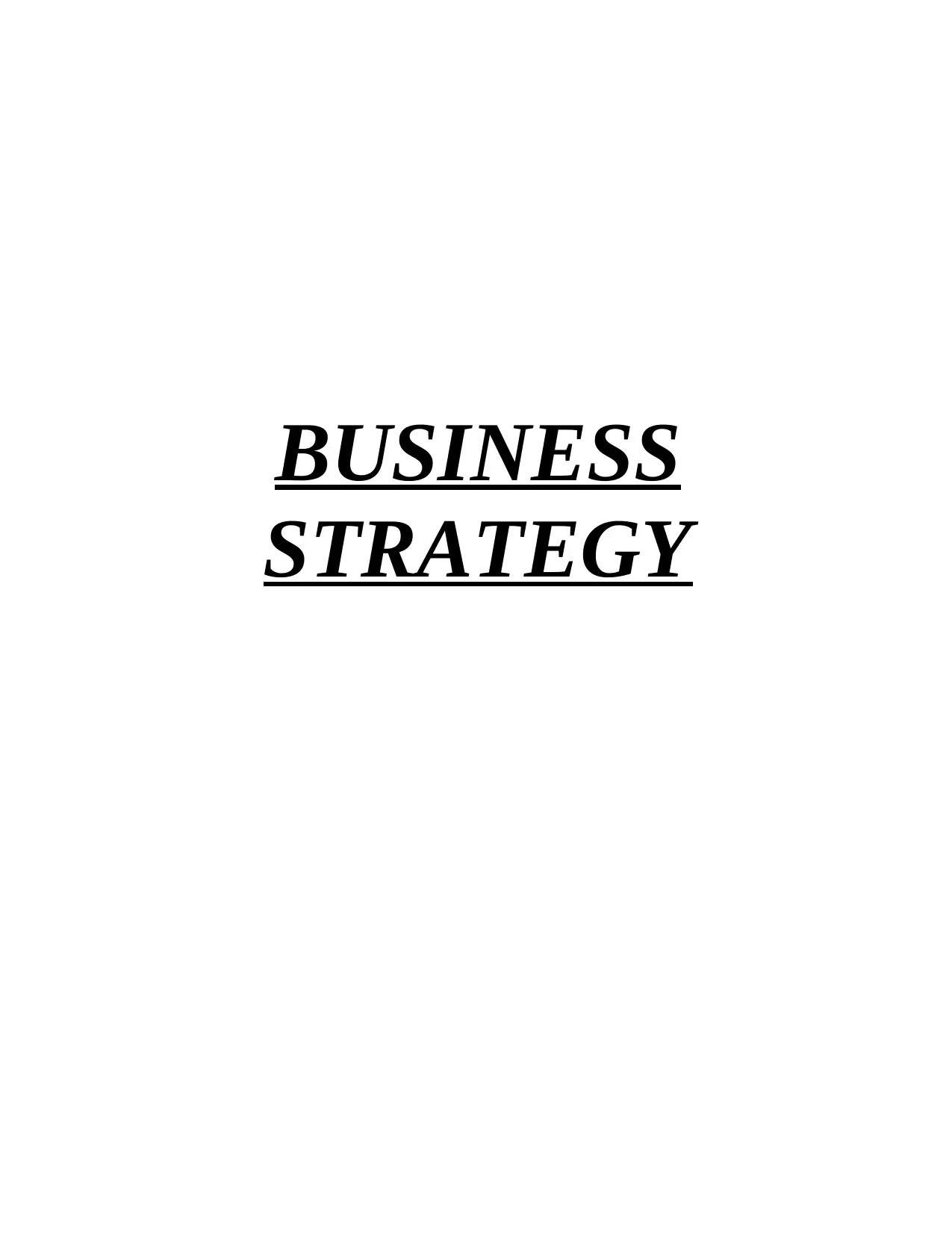
BUSINESS
STRATEGY
STRATEGY
Paraphrase This Document
Need a fresh take? Get an instant paraphrase of this document with our AI Paraphraser
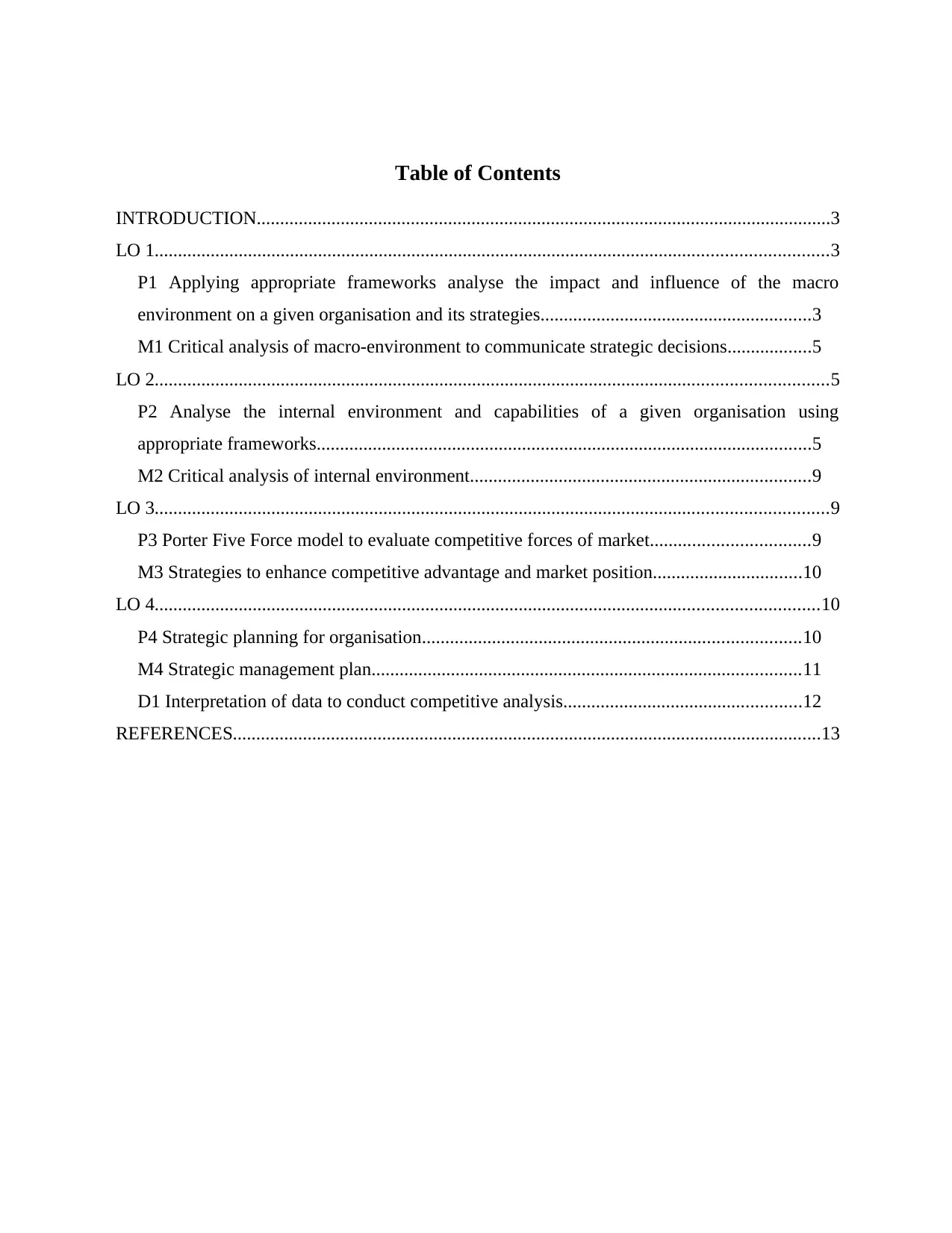
Table of Contents
INTRODUCTION...........................................................................................................................3
LO 1................................................................................................................................................3
P1 Applying appropriate frameworks analyse the impact and influence of the macro
environment on a given organisation and its strategies..........................................................3
M1 Critical analysis of macro-environment to communicate strategic decisions..................5
LO 2................................................................................................................................................5
P2 Analyse the internal environment and capabilities of a given organisation using
appropriate frameworks..........................................................................................................5
M2 Critical analysis of internal environment.........................................................................9
LO 3................................................................................................................................................9
P3 Porter Five Force model to evaluate competitive forces of market..................................9
M3 Strategies to enhance competitive advantage and market position................................10
LO 4..............................................................................................................................................10
P4 Strategic planning for organisation.................................................................................10
M4 Strategic management plan............................................................................................11
D1 Interpretation of data to conduct competitive analysis...................................................12
REFERENCES..............................................................................................................................13
INTRODUCTION...........................................................................................................................3
LO 1................................................................................................................................................3
P1 Applying appropriate frameworks analyse the impact and influence of the macro
environment on a given organisation and its strategies..........................................................3
M1 Critical analysis of macro-environment to communicate strategic decisions..................5
LO 2................................................................................................................................................5
P2 Analyse the internal environment and capabilities of a given organisation using
appropriate frameworks..........................................................................................................5
M2 Critical analysis of internal environment.........................................................................9
LO 3................................................................................................................................................9
P3 Porter Five Force model to evaluate competitive forces of market..................................9
M3 Strategies to enhance competitive advantage and market position................................10
LO 4..............................................................................................................................................10
P4 Strategic planning for organisation.................................................................................10
M4 Strategic management plan............................................................................................11
D1 Interpretation of data to conduct competitive analysis...................................................12
REFERENCES..............................................................................................................................13
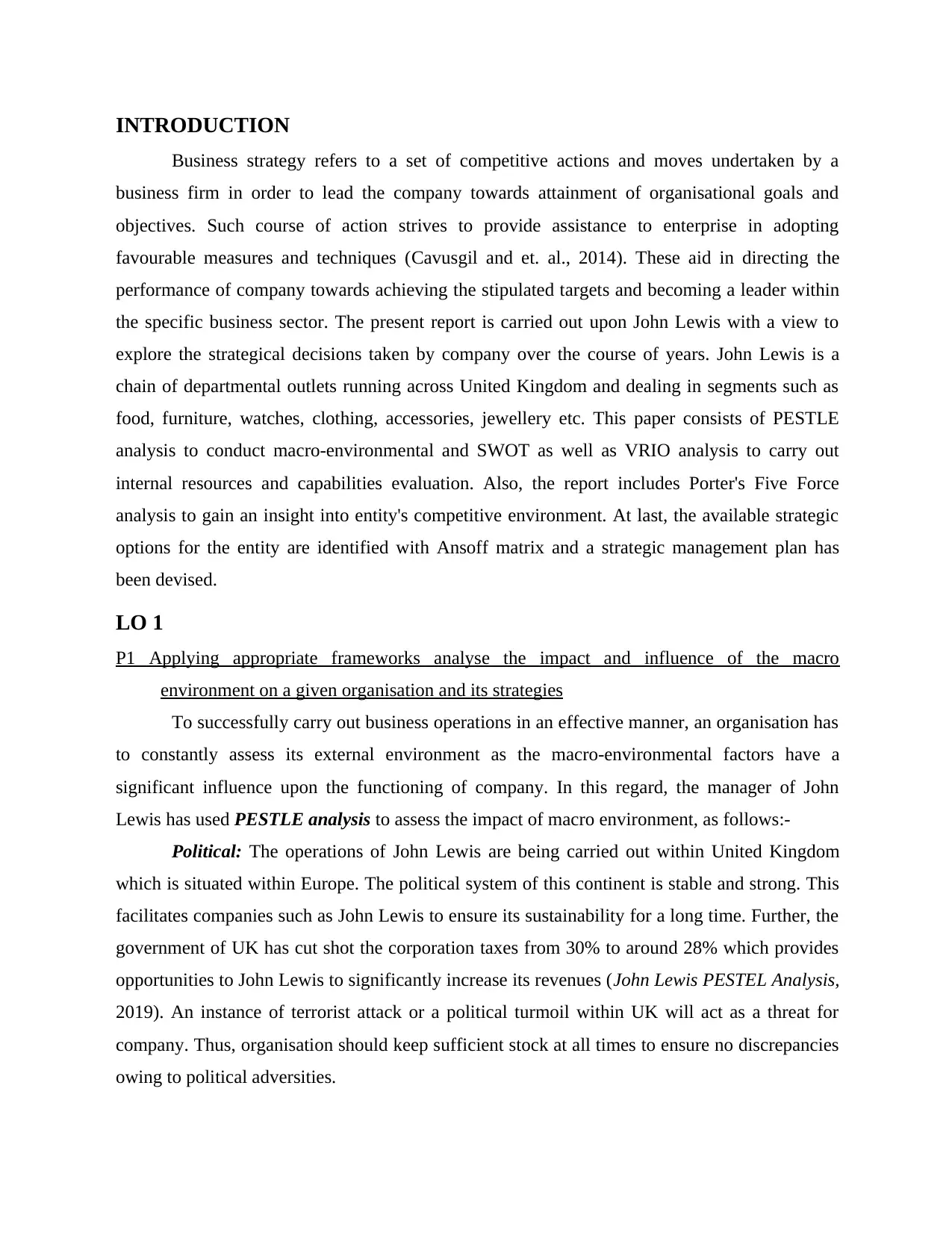
INTRODUCTION
Business strategy refers to a set of competitive actions and moves undertaken by a
business firm in order to lead the company towards attainment of organisational goals and
objectives. Such course of action strives to provide assistance to enterprise in adopting
favourable measures and techniques (Cavusgil and et. al., 2014). These aid in directing the
performance of company towards achieving the stipulated targets and becoming a leader within
the specific business sector. The present report is carried out upon John Lewis with a view to
explore the strategical decisions taken by company over the course of years. John Lewis is a
chain of departmental outlets running across United Kingdom and dealing in segments such as
food, furniture, watches, clothing, accessories, jewellery etc. This paper consists of PESTLE
analysis to conduct macro-environmental and SWOT as well as VRIO analysis to carry out
internal resources and capabilities evaluation. Also, the report includes Porter's Five Force
analysis to gain an insight into entity's competitive environment. At last, the available strategic
options for the entity are identified with Ansoff matrix and a strategic management plan has
been devised.
LO 1
P1 Applying appropriate frameworks analyse the impact and influence of the macro
environment on a given organisation and its strategies
To successfully carry out business operations in an effective manner, an organisation has
to constantly assess its external environment as the macro-environmental factors have a
significant influence upon the functioning of company. In this regard, the manager of John
Lewis has used PESTLE analysis to assess the impact of macro environment, as follows:-
Political: The operations of John Lewis are being carried out within United Kingdom
which is situated within Europe. The political system of this continent is stable and strong. This
facilitates companies such as John Lewis to ensure its sustainability for a long time. Further, the
government of UK has cut shot the corporation taxes from 30% to around 28% which provides
opportunities to John Lewis to significantly increase its revenues (John Lewis PESTEL Analysis,
2019). An instance of terrorist attack or a political turmoil within UK will act as a threat for
company. Thus, organisation should keep sufficient stock at all times to ensure no discrepancies
owing to political adversities.
Business strategy refers to a set of competitive actions and moves undertaken by a
business firm in order to lead the company towards attainment of organisational goals and
objectives. Such course of action strives to provide assistance to enterprise in adopting
favourable measures and techniques (Cavusgil and et. al., 2014). These aid in directing the
performance of company towards achieving the stipulated targets and becoming a leader within
the specific business sector. The present report is carried out upon John Lewis with a view to
explore the strategical decisions taken by company over the course of years. John Lewis is a
chain of departmental outlets running across United Kingdom and dealing in segments such as
food, furniture, watches, clothing, accessories, jewellery etc. This paper consists of PESTLE
analysis to conduct macro-environmental and SWOT as well as VRIO analysis to carry out
internal resources and capabilities evaluation. Also, the report includes Porter's Five Force
analysis to gain an insight into entity's competitive environment. At last, the available strategic
options for the entity are identified with Ansoff matrix and a strategic management plan has
been devised.
LO 1
P1 Applying appropriate frameworks analyse the impact and influence of the macro
environment on a given organisation and its strategies
To successfully carry out business operations in an effective manner, an organisation has
to constantly assess its external environment as the macro-environmental factors have a
significant influence upon the functioning of company. In this regard, the manager of John
Lewis has used PESTLE analysis to assess the impact of macro environment, as follows:-
Political: The operations of John Lewis are being carried out within United Kingdom
which is situated within Europe. The political system of this continent is stable and strong. This
facilitates companies such as John Lewis to ensure its sustainability for a long time. Further, the
government of UK has cut shot the corporation taxes from 30% to around 28% which provides
opportunities to John Lewis to significantly increase its revenues (John Lewis PESTEL Analysis,
2019). An instance of terrorist attack or a political turmoil within UK will act as a threat for
company. Thus, organisation should keep sufficient stock at all times to ensure no discrepancies
owing to political adversities.
⊘ This is a preview!⊘
Do you want full access?
Subscribe today to unlock all pages.

Trusted by 1+ million students worldwide
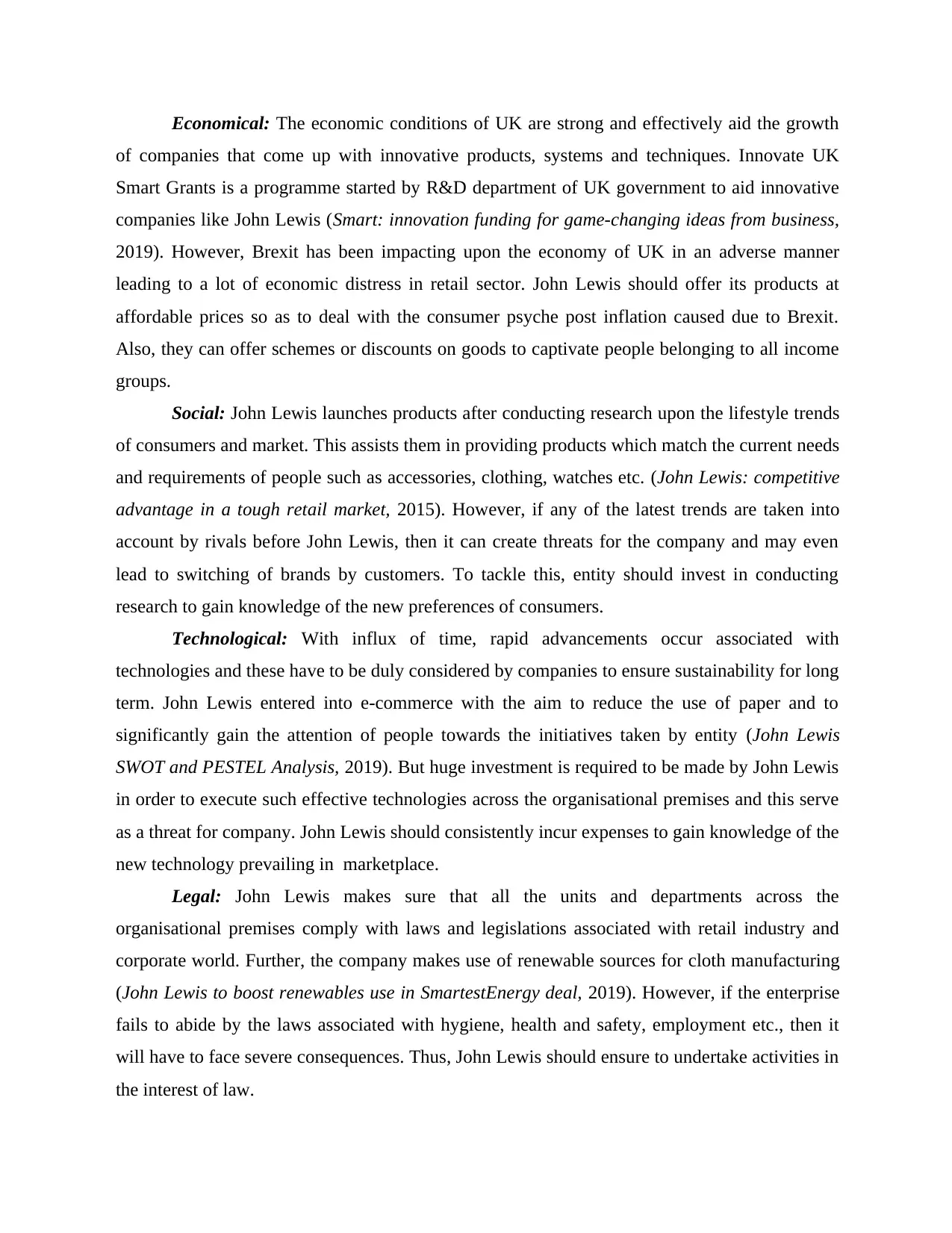
Economical: The economic conditions of UK are strong and effectively aid the growth
of companies that come up with innovative products, systems and techniques. Innovate UK
Smart Grants is a programme started by R&D department of UK government to aid innovative
companies like John Lewis (Smart: innovation funding for game-changing ideas from business,
2019). However, Brexit has been impacting upon the economy of UK in an adverse manner
leading to a lot of economic distress in retail sector. John Lewis should offer its products at
affordable prices so as to deal with the consumer psyche post inflation caused due to Brexit.
Also, they can offer schemes or discounts on goods to captivate people belonging to all income
groups.
Social: John Lewis launches products after conducting research upon the lifestyle trends
of consumers and market. This assists them in providing products which match the current needs
and requirements of people such as accessories, clothing, watches etc. (John Lewis: competitive
advantage in a tough retail market, 2015). However, if any of the latest trends are taken into
account by rivals before John Lewis, then it can create threats for the company and may even
lead to switching of brands by customers. To tackle this, entity should invest in conducting
research to gain knowledge of the new preferences of consumers.
Technological: With influx of time, rapid advancements occur associated with
technologies and these have to be duly considered by companies to ensure sustainability for long
term. John Lewis entered into e-commerce with the aim to reduce the use of paper and to
significantly gain the attention of people towards the initiatives taken by entity (John Lewis
SWOT and PESTEL Analysis, 2019). But huge investment is required to be made by John Lewis
in order to execute such effective technologies across the organisational premises and this serve
as a threat for company. John Lewis should consistently incur expenses to gain knowledge of the
new technology prevailing in marketplace.
Legal: John Lewis makes sure that all the units and departments across the
organisational premises comply with laws and legislations associated with retail industry and
corporate world. Further, the company makes use of renewable sources for cloth manufacturing
(John Lewis to boost renewables use in SmartestEnergy deal, 2019). However, if the enterprise
fails to abide by the laws associated with hygiene, health and safety, employment etc., then it
will have to face severe consequences. Thus, John Lewis should ensure to undertake activities in
the interest of law.
of companies that come up with innovative products, systems and techniques. Innovate UK
Smart Grants is a programme started by R&D department of UK government to aid innovative
companies like John Lewis (Smart: innovation funding for game-changing ideas from business,
2019). However, Brexit has been impacting upon the economy of UK in an adverse manner
leading to a lot of economic distress in retail sector. John Lewis should offer its products at
affordable prices so as to deal with the consumer psyche post inflation caused due to Brexit.
Also, they can offer schemes or discounts on goods to captivate people belonging to all income
groups.
Social: John Lewis launches products after conducting research upon the lifestyle trends
of consumers and market. This assists them in providing products which match the current needs
and requirements of people such as accessories, clothing, watches etc. (John Lewis: competitive
advantage in a tough retail market, 2015). However, if any of the latest trends are taken into
account by rivals before John Lewis, then it can create threats for the company and may even
lead to switching of brands by customers. To tackle this, entity should invest in conducting
research to gain knowledge of the new preferences of consumers.
Technological: With influx of time, rapid advancements occur associated with
technologies and these have to be duly considered by companies to ensure sustainability for long
term. John Lewis entered into e-commerce with the aim to reduce the use of paper and to
significantly gain the attention of people towards the initiatives taken by entity (John Lewis
SWOT and PESTEL Analysis, 2019). But huge investment is required to be made by John Lewis
in order to execute such effective technologies across the organisational premises and this serve
as a threat for company. John Lewis should consistently incur expenses to gain knowledge of the
new technology prevailing in marketplace.
Legal: John Lewis makes sure that all the units and departments across the
organisational premises comply with laws and legislations associated with retail industry and
corporate world. Further, the company makes use of renewable sources for cloth manufacturing
(John Lewis to boost renewables use in SmartestEnergy deal, 2019). However, if the enterprise
fails to abide by the laws associated with hygiene, health and safety, employment etc., then it
will have to face severe consequences. Thus, John Lewis should ensure to undertake activities in
the interest of law.
Paraphrase This Document
Need a fresh take? Get an instant paraphrase of this document with our AI Paraphraser
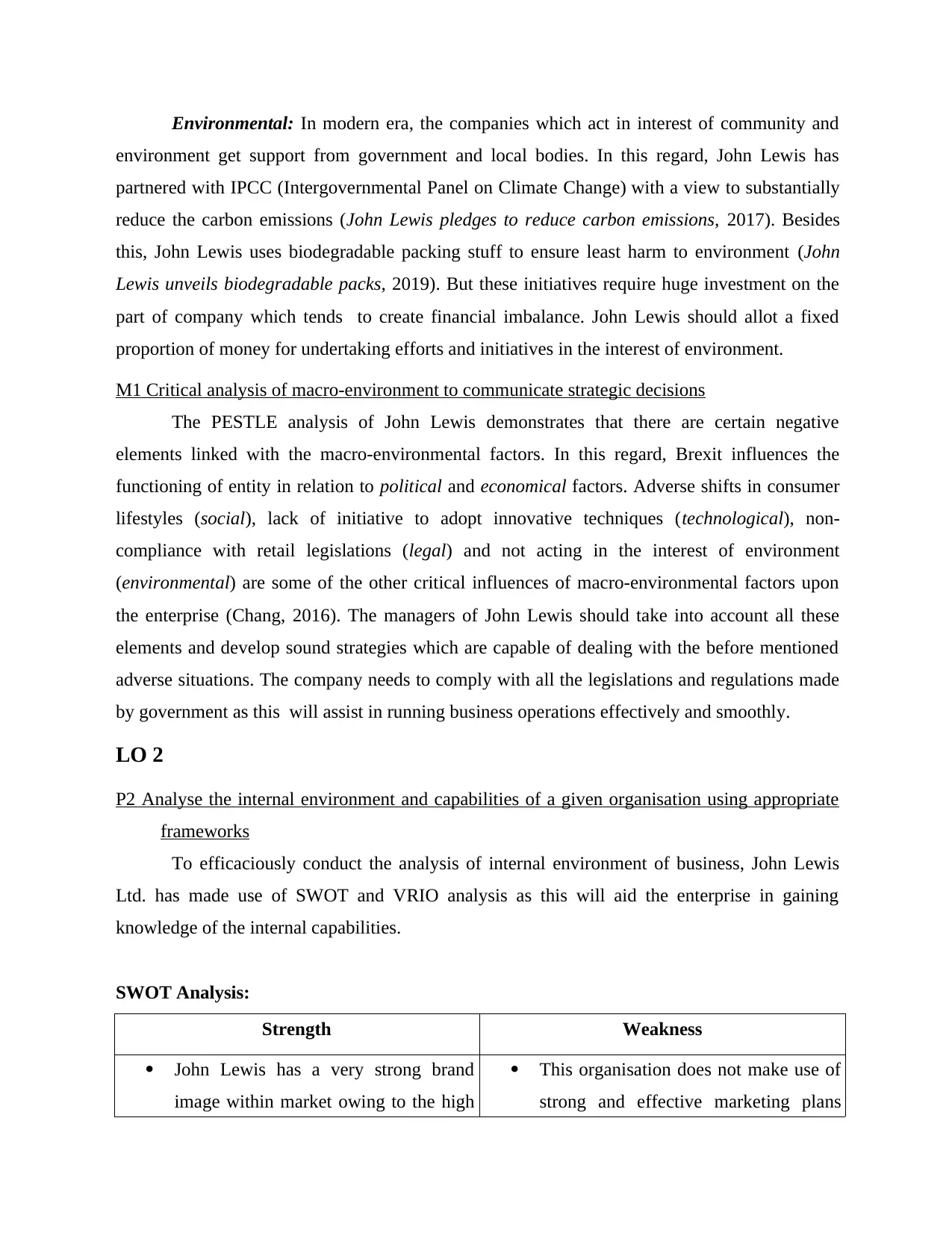
Environmental: In modern era, the companies which act in interest of community and
environment get support from government and local bodies. In this regard, John Lewis has
partnered with IPCC (Intergovernmental Panel on Climate Change) with a view to substantially
reduce the carbon emissions (John Lewis pledges to reduce carbon emissions, 2017). Besides
this, John Lewis uses biodegradable packing stuff to ensure least harm to environment (John
Lewis unveils biodegradable packs, 2019). But these initiatives require huge investment on the
part of company which tends to create financial imbalance. John Lewis should allot a fixed
proportion of money for undertaking efforts and initiatives in the interest of environment.
M1 Critical analysis of macro-environment to communicate strategic decisions
The PESTLE analysis of John Lewis demonstrates that there are certain negative
elements linked with the macro-environmental factors. In this regard, Brexit influences the
functioning of entity in relation to political and economical factors. Adverse shifts in consumer
lifestyles (social), lack of initiative to adopt innovative techniques (technological), non-
compliance with retail legislations (legal) and not acting in the interest of environment
(environmental) are some of the other critical influences of macro-environmental factors upon
the enterprise (Chang, 2016). The managers of John Lewis should take into account all these
elements and develop sound strategies which are capable of dealing with the before mentioned
adverse situations. The company needs to comply with all the legislations and regulations made
by government as this will assist in running business operations effectively and smoothly.
LO 2
P2 Analyse the internal environment and capabilities of a given organisation using appropriate
frameworks
To efficaciously conduct the analysis of internal environment of business, John Lewis
Ltd. has made use of SWOT and VRIO analysis as this will aid the enterprise in gaining
knowledge of the internal capabilities.
SWOT Analysis:
Strength Weakness
John Lewis has a very strong brand
image within market owing to the high
This organisation does not make use of
strong and effective marketing plans
environment get support from government and local bodies. In this regard, John Lewis has
partnered with IPCC (Intergovernmental Panel on Climate Change) with a view to substantially
reduce the carbon emissions (John Lewis pledges to reduce carbon emissions, 2017). Besides
this, John Lewis uses biodegradable packing stuff to ensure least harm to environment (John
Lewis unveils biodegradable packs, 2019). But these initiatives require huge investment on the
part of company which tends to create financial imbalance. John Lewis should allot a fixed
proportion of money for undertaking efforts and initiatives in the interest of environment.
M1 Critical analysis of macro-environment to communicate strategic decisions
The PESTLE analysis of John Lewis demonstrates that there are certain negative
elements linked with the macro-environmental factors. In this regard, Brexit influences the
functioning of entity in relation to political and economical factors. Adverse shifts in consumer
lifestyles (social), lack of initiative to adopt innovative techniques (technological), non-
compliance with retail legislations (legal) and not acting in the interest of environment
(environmental) are some of the other critical influences of macro-environmental factors upon
the enterprise (Chang, 2016). The managers of John Lewis should take into account all these
elements and develop sound strategies which are capable of dealing with the before mentioned
adverse situations. The company needs to comply with all the legislations and regulations made
by government as this will assist in running business operations effectively and smoothly.
LO 2
P2 Analyse the internal environment and capabilities of a given organisation using appropriate
frameworks
To efficaciously conduct the analysis of internal environment of business, John Lewis
Ltd. has made use of SWOT and VRIO analysis as this will aid the enterprise in gaining
knowledge of the internal capabilities.
SWOT Analysis:
Strength Weakness
John Lewis has a very strong brand
image within market owing to the high
This organisation does not make use of
strong and effective marketing plans
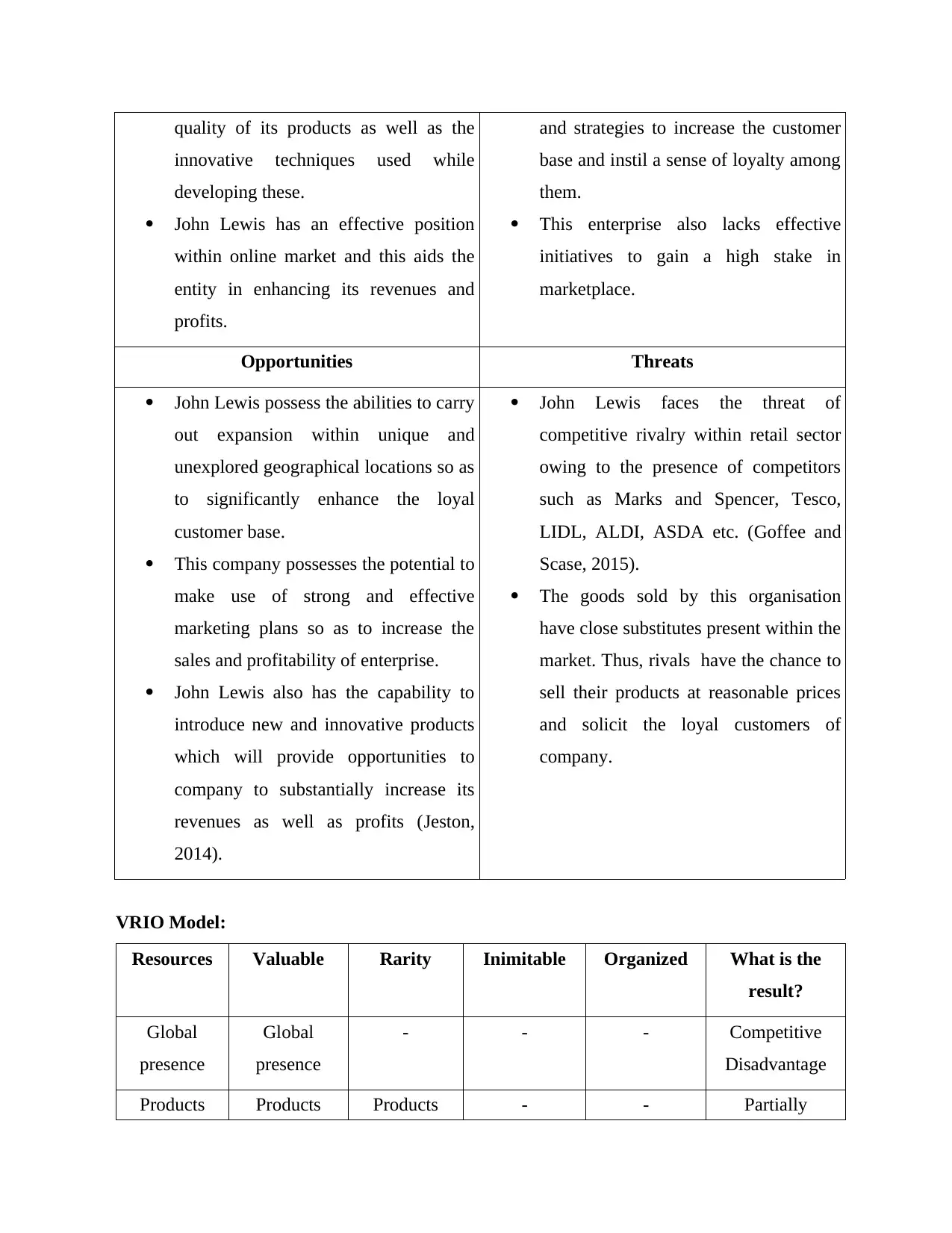
quality of its products as well as the
innovative techniques used while
developing these.
John Lewis has an effective position
within online market and this aids the
entity in enhancing its revenues and
profits.
and strategies to increase the customer
base and instil a sense of loyalty among
them.
This enterprise also lacks effective
initiatives to gain a high stake in
marketplace.
Opportunities Threats
John Lewis possess the abilities to carry
out expansion within unique and
unexplored geographical locations so as
to significantly enhance the loyal
customer base.
This company possesses the potential to
make use of strong and effective
marketing plans so as to increase the
sales and profitability of enterprise.
John Lewis also has the capability to
introduce new and innovative products
which will provide opportunities to
company to substantially increase its
revenues as well as profits (Jeston,
2014).
John Lewis faces the threat of
competitive rivalry within retail sector
owing to the presence of competitors
such as Marks and Spencer, Tesco,
LIDL, ALDI, ASDA etc. (Goffee and
Scase, 2015).
The goods sold by this organisation
have close substitutes present within the
market. Thus, rivals have the chance to
sell their products at reasonable prices
and solicit the loyal customers of
company.
VRIO Model:
Resources Valuable Rarity Inimitable Organized What is the
result?
Global
presence
Global
presence
- - - Competitive
Disadvantage
Products Products Products - - Partially
innovative techniques used while
developing these.
John Lewis has an effective position
within online market and this aids the
entity in enhancing its revenues and
profits.
and strategies to increase the customer
base and instil a sense of loyalty among
them.
This enterprise also lacks effective
initiatives to gain a high stake in
marketplace.
Opportunities Threats
John Lewis possess the abilities to carry
out expansion within unique and
unexplored geographical locations so as
to significantly enhance the loyal
customer base.
This company possesses the potential to
make use of strong and effective
marketing plans so as to increase the
sales and profitability of enterprise.
John Lewis also has the capability to
introduce new and innovative products
which will provide opportunities to
company to substantially increase its
revenues as well as profits (Jeston,
2014).
John Lewis faces the threat of
competitive rivalry within retail sector
owing to the presence of competitors
such as Marks and Spencer, Tesco,
LIDL, ALDI, ASDA etc. (Goffee and
Scase, 2015).
The goods sold by this organisation
have close substitutes present within the
market. Thus, rivals have the chance to
sell their products at reasonable prices
and solicit the loyal customers of
company.
VRIO Model:
Resources Valuable Rarity Inimitable Organized What is the
result?
Global
presence
Global
presence
- - - Competitive
Disadvantage
Products Products Products - - Partially
⊘ This is a preview!⊘
Do you want full access?
Subscribe today to unlock all pages.

Trusted by 1+ million students worldwide
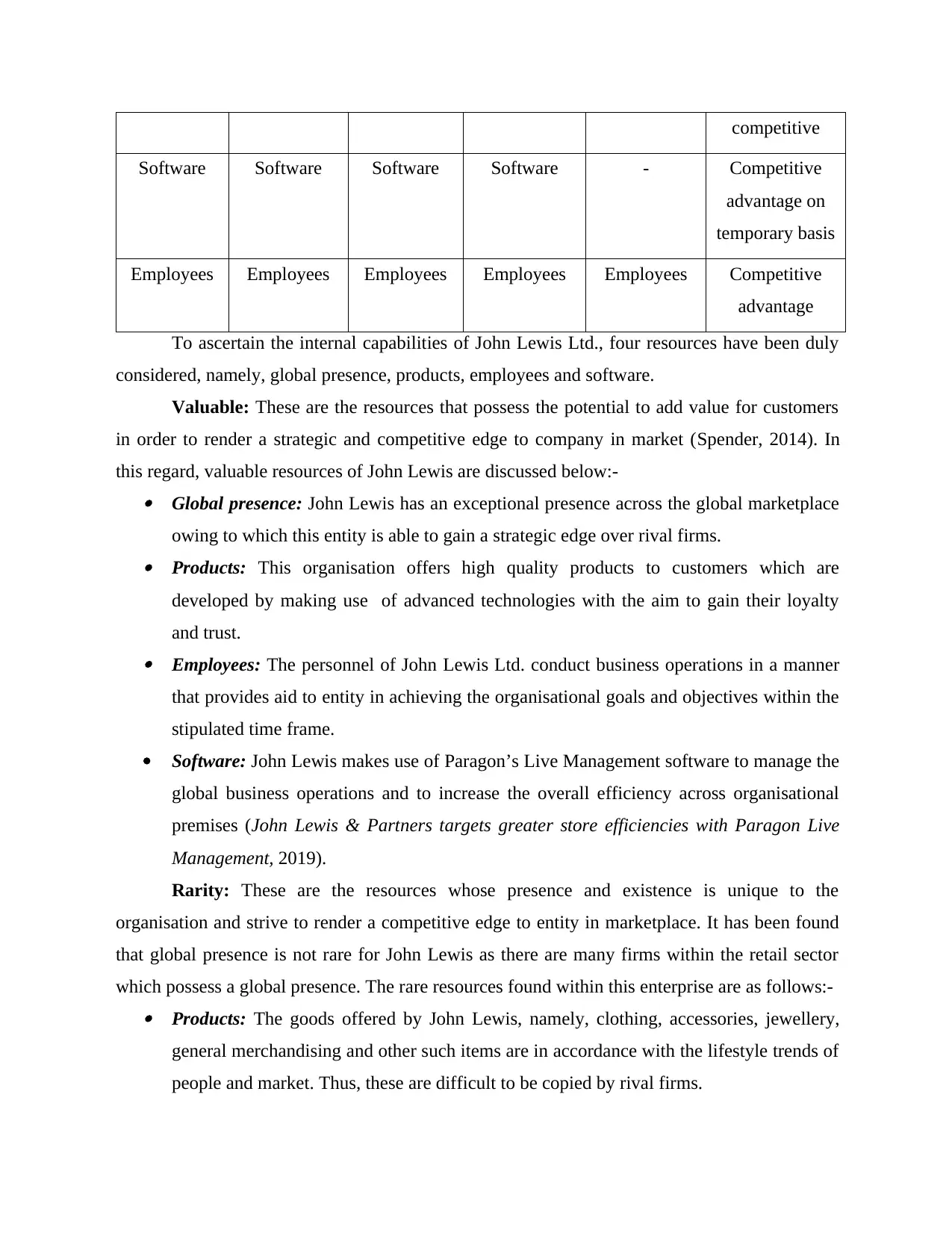
competitive
Software Software Software Software - Competitive
advantage on
temporary basis
Employees Employees Employees Employees Employees Competitive
advantage
To ascertain the internal capabilities of John Lewis Ltd., four resources have been duly
considered, namely, global presence, products, employees and software.
Valuable: These are the resources that possess the potential to add value for customers
in order to render a strategic and competitive edge to company in market (Spender, 2014). In
this regard, valuable resources of John Lewis are discussed below:- Global presence: John Lewis has an exceptional presence across the global marketplace
owing to which this entity is able to gain a strategic edge over rival firms. Products: This organisation offers high quality products to customers which are
developed by making use of advanced technologies with the aim to gain their loyalty
and trust. Employees: The personnel of John Lewis Ltd. conduct business operations in a manner
that provides aid to entity in achieving the organisational goals and objectives within the
stipulated time frame.
Software: John Lewis makes use of Paragon’s Live Management software to manage the
global business operations and to increase the overall efficiency across organisational
premises (John Lewis & Partners targets greater store efficiencies with Paragon Live
Management, 2019).
Rarity: These are the resources whose presence and existence is unique to the
organisation and strive to render a competitive edge to entity in marketplace. It has been found
that global presence is not rare for John Lewis as there are many firms within the retail sector
which possess a global presence. The rare resources found within this enterprise are as follows:- Products: The goods offered by John Lewis, namely, clothing, accessories, jewellery,
general merchandising and other such items are in accordance with the lifestyle trends of
people and market. Thus, these are difficult to be copied by rival firms.
Software Software Software Software - Competitive
advantage on
temporary basis
Employees Employees Employees Employees Employees Competitive
advantage
To ascertain the internal capabilities of John Lewis Ltd., four resources have been duly
considered, namely, global presence, products, employees and software.
Valuable: These are the resources that possess the potential to add value for customers
in order to render a strategic and competitive edge to company in market (Spender, 2014). In
this regard, valuable resources of John Lewis are discussed below:- Global presence: John Lewis has an exceptional presence across the global marketplace
owing to which this entity is able to gain a strategic edge over rival firms. Products: This organisation offers high quality products to customers which are
developed by making use of advanced technologies with the aim to gain their loyalty
and trust. Employees: The personnel of John Lewis Ltd. conduct business operations in a manner
that provides aid to entity in achieving the organisational goals and objectives within the
stipulated time frame.
Software: John Lewis makes use of Paragon’s Live Management software to manage the
global business operations and to increase the overall efficiency across organisational
premises (John Lewis & Partners targets greater store efficiencies with Paragon Live
Management, 2019).
Rarity: These are the resources whose presence and existence is unique to the
organisation and strive to render a competitive edge to entity in marketplace. It has been found
that global presence is not rare for John Lewis as there are many firms within the retail sector
which possess a global presence. The rare resources found within this enterprise are as follows:- Products: The goods offered by John Lewis, namely, clothing, accessories, jewellery,
general merchandising and other such items are in accordance with the lifestyle trends of
people and market. Thus, these are difficult to be copied by rival firms.
Paraphrase This Document
Need a fresh take? Get an instant paraphrase of this document with our AI Paraphraser
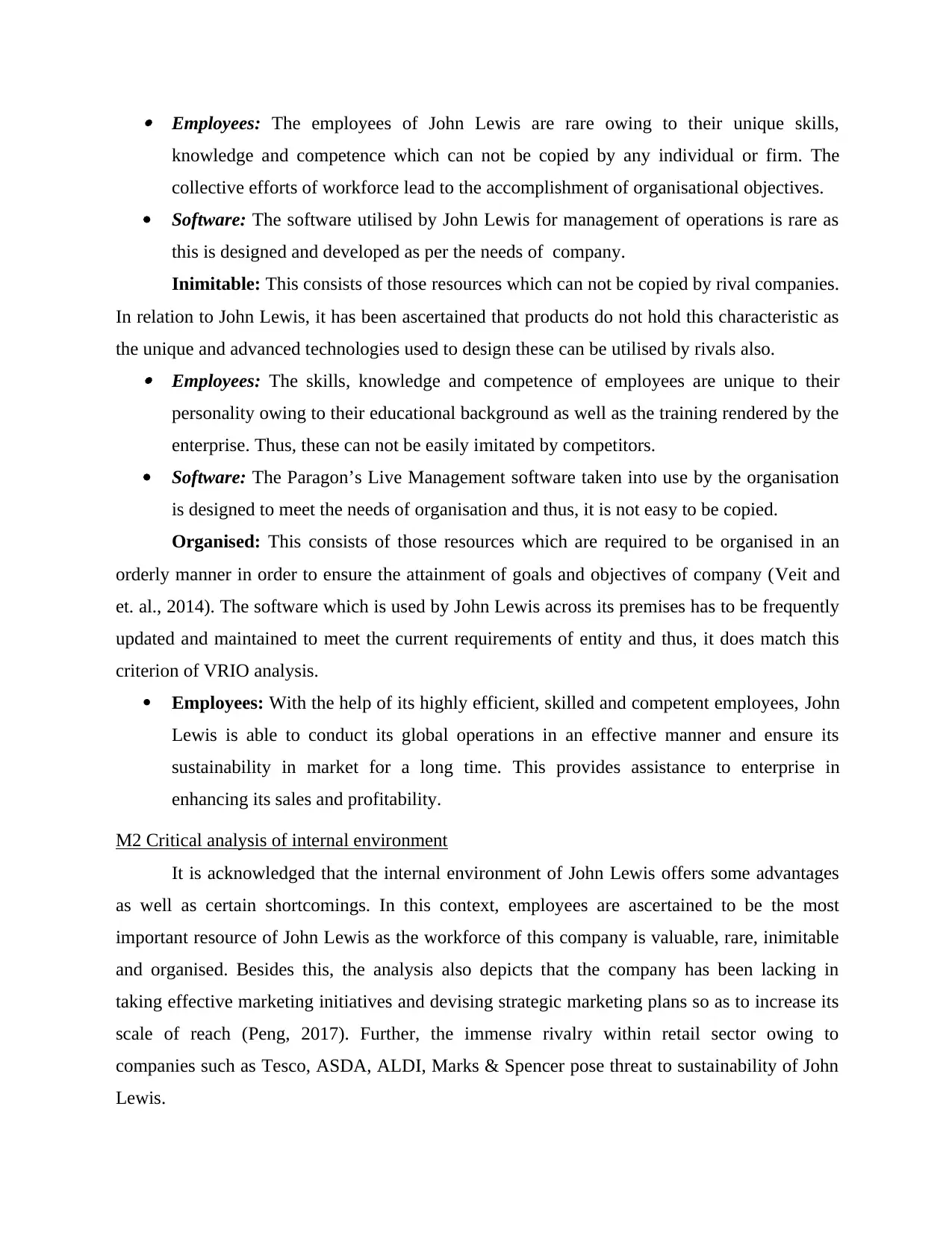
Employees: The employees of John Lewis are rare owing to their unique skills,
knowledge and competence which can not be copied by any individual or firm. The
collective efforts of workforce lead to the accomplishment of organisational objectives.
Software: The software utilised by John Lewis for management of operations is rare as
this is designed and developed as per the needs of company.
Inimitable: This consists of those resources which can not be copied by rival companies.
In relation to John Lewis, it has been ascertained that products do not hold this characteristic as
the unique and advanced technologies used to design these can be utilised by rivals also. Employees: The skills, knowledge and competence of employees are unique to their
personality owing to their educational background as well as the training rendered by the
enterprise. Thus, these can not be easily imitated by competitors.
Software: The Paragon’s Live Management software taken into use by the organisation
is designed to meet the needs of organisation and thus, it is not easy to be copied.
Organised: This consists of those resources which are required to be organised in an
orderly manner in order to ensure the attainment of goals and objectives of company (Veit and
et. al., 2014). The software which is used by John Lewis across its premises has to be frequently
updated and maintained to meet the current requirements of entity and thus, it does match this
criterion of VRIO analysis.
Employees: With the help of its highly efficient, skilled and competent employees, John
Lewis is able to conduct its global operations in an effective manner and ensure its
sustainability in market for a long time. This provides assistance to enterprise in
enhancing its sales and profitability.
M2 Critical analysis of internal environment
It is acknowledged that the internal environment of John Lewis offers some advantages
as well as certain shortcomings. In this context, employees are ascertained to be the most
important resource of John Lewis as the workforce of this company is valuable, rare, inimitable
and organised. Besides this, the analysis also depicts that the company has been lacking in
taking effective marketing initiatives and devising strategic marketing plans so as to increase its
scale of reach (Peng, 2017). Further, the immense rivalry within retail sector owing to
companies such as Tesco, ASDA, ALDI, Marks & Spencer pose threat to sustainability of John
Lewis.
knowledge and competence which can not be copied by any individual or firm. The
collective efforts of workforce lead to the accomplishment of organisational objectives.
Software: The software utilised by John Lewis for management of operations is rare as
this is designed and developed as per the needs of company.
Inimitable: This consists of those resources which can not be copied by rival companies.
In relation to John Lewis, it has been ascertained that products do not hold this characteristic as
the unique and advanced technologies used to design these can be utilised by rivals also. Employees: The skills, knowledge and competence of employees are unique to their
personality owing to their educational background as well as the training rendered by the
enterprise. Thus, these can not be easily imitated by competitors.
Software: The Paragon’s Live Management software taken into use by the organisation
is designed to meet the needs of organisation and thus, it is not easy to be copied.
Organised: This consists of those resources which are required to be organised in an
orderly manner in order to ensure the attainment of goals and objectives of company (Veit and
et. al., 2014). The software which is used by John Lewis across its premises has to be frequently
updated and maintained to meet the current requirements of entity and thus, it does match this
criterion of VRIO analysis.
Employees: With the help of its highly efficient, skilled and competent employees, John
Lewis is able to conduct its global operations in an effective manner and ensure its
sustainability in market for a long time. This provides assistance to enterprise in
enhancing its sales and profitability.
M2 Critical analysis of internal environment
It is acknowledged that the internal environment of John Lewis offers some advantages
as well as certain shortcomings. In this context, employees are ascertained to be the most
important resource of John Lewis as the workforce of this company is valuable, rare, inimitable
and organised. Besides this, the analysis also depicts that the company has been lacking in
taking effective marketing initiatives and devising strategic marketing plans so as to increase its
scale of reach (Peng, 2017). Further, the immense rivalry within retail sector owing to
companies such as Tesco, ASDA, ALDI, Marks & Spencer pose threat to sustainability of John
Lewis.
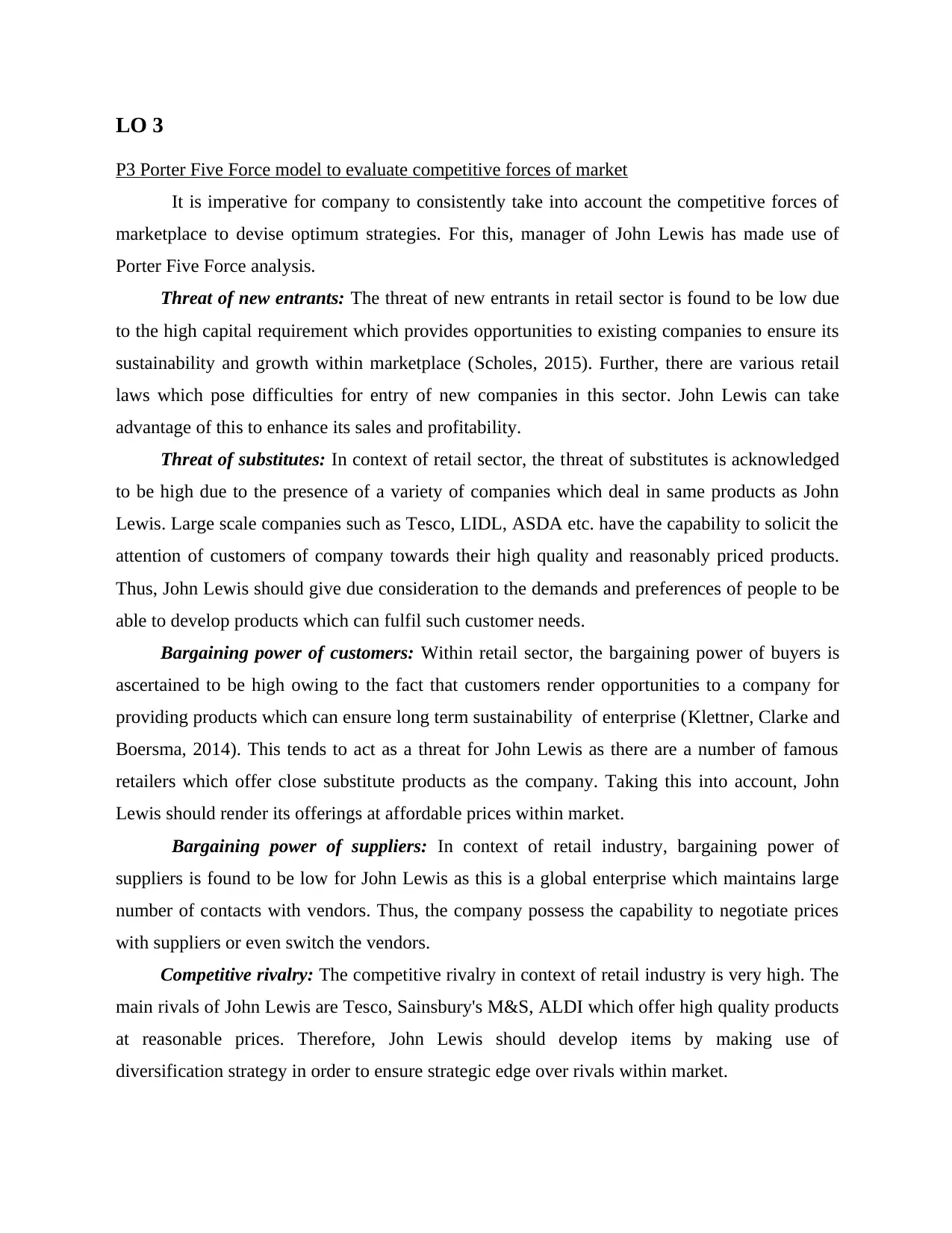
LO 3
P3 Porter Five Force model to evaluate competitive forces of market
It is imperative for company to consistently take into account the competitive forces of
marketplace to devise optimum strategies. For this, manager of John Lewis has made use of
Porter Five Force analysis.
Threat of new entrants: The threat of new entrants in retail sector is found to be low due
to the high capital requirement which provides opportunities to existing companies to ensure its
sustainability and growth within marketplace (Scholes, 2015). Further, there are various retail
laws which pose difficulties for entry of new companies in this sector. John Lewis can take
advantage of this to enhance its sales and profitability.
Threat of substitutes: In context of retail sector, the threat of substitutes is acknowledged
to be high due to the presence of a variety of companies which deal in same products as John
Lewis. Large scale companies such as Tesco, LIDL, ASDA etc. have the capability to solicit the
attention of customers of company towards their high quality and reasonably priced products.
Thus, John Lewis should give due consideration to the demands and preferences of people to be
able to develop products which can fulfil such customer needs.
Bargaining power of customers: Within retail sector, the bargaining power of buyers is
ascertained to be high owing to the fact that customers render opportunities to a company for
providing products which can ensure long term sustainability of enterprise (Klettner, Clarke and
Boersma, 2014). This tends to act as a threat for John Lewis as there are a number of famous
retailers which offer close substitute products as the company. Taking this into account, John
Lewis should render its offerings at affordable prices within market.
Bargaining power of suppliers: In context of retail industry, bargaining power of
suppliers is found to be low for John Lewis as this is a global enterprise which maintains large
number of contacts with vendors. Thus, the company possess the capability to negotiate prices
with suppliers or even switch the vendors.
Competitive rivalry: The competitive rivalry in context of retail industry is very high. The
main rivals of John Lewis are Tesco, Sainsbury's M&S, ALDI which offer high quality products
at reasonable prices. Therefore, John Lewis should develop items by making use of
diversification strategy in order to ensure strategic edge over rivals within market.
P3 Porter Five Force model to evaluate competitive forces of market
It is imperative for company to consistently take into account the competitive forces of
marketplace to devise optimum strategies. For this, manager of John Lewis has made use of
Porter Five Force analysis.
Threat of new entrants: The threat of new entrants in retail sector is found to be low due
to the high capital requirement which provides opportunities to existing companies to ensure its
sustainability and growth within marketplace (Scholes, 2015). Further, there are various retail
laws which pose difficulties for entry of new companies in this sector. John Lewis can take
advantage of this to enhance its sales and profitability.
Threat of substitutes: In context of retail sector, the threat of substitutes is acknowledged
to be high due to the presence of a variety of companies which deal in same products as John
Lewis. Large scale companies such as Tesco, LIDL, ASDA etc. have the capability to solicit the
attention of customers of company towards their high quality and reasonably priced products.
Thus, John Lewis should give due consideration to the demands and preferences of people to be
able to develop products which can fulfil such customer needs.
Bargaining power of customers: Within retail sector, the bargaining power of buyers is
ascertained to be high owing to the fact that customers render opportunities to a company for
providing products which can ensure long term sustainability of enterprise (Klettner, Clarke and
Boersma, 2014). This tends to act as a threat for John Lewis as there are a number of famous
retailers which offer close substitute products as the company. Taking this into account, John
Lewis should render its offerings at affordable prices within market.
Bargaining power of suppliers: In context of retail industry, bargaining power of
suppliers is found to be low for John Lewis as this is a global enterprise which maintains large
number of contacts with vendors. Thus, the company possess the capability to negotiate prices
with suppliers or even switch the vendors.
Competitive rivalry: The competitive rivalry in context of retail industry is very high. The
main rivals of John Lewis are Tesco, Sainsbury's M&S, ALDI which offer high quality products
at reasonable prices. Therefore, John Lewis should develop items by making use of
diversification strategy in order to ensure strategic edge over rivals within market.
⊘ This is a preview!⊘
Do you want full access?
Subscribe today to unlock all pages.

Trusted by 1+ million students worldwide
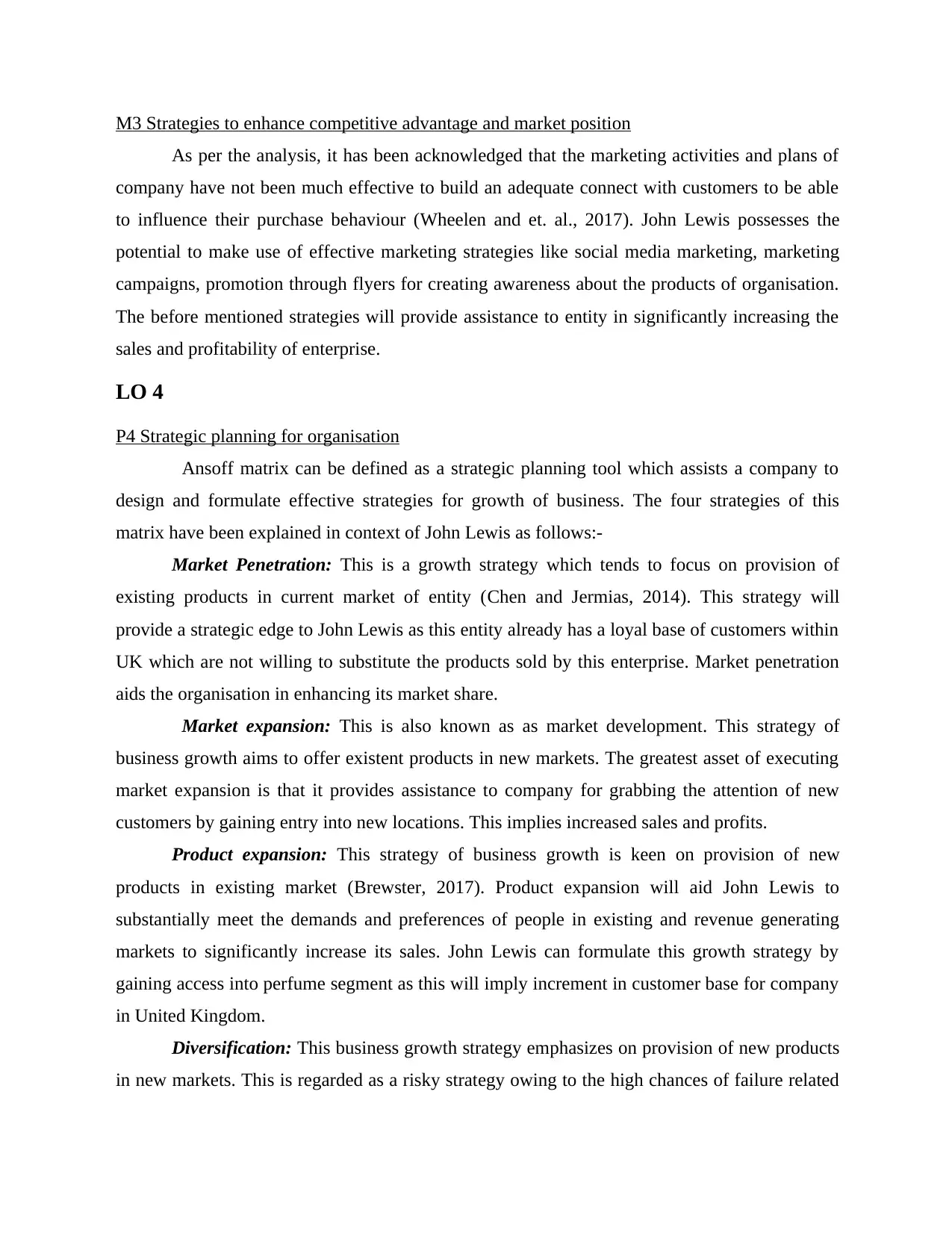
M3 Strategies to enhance competitive advantage and market position
As per the analysis, it has been acknowledged that the marketing activities and plans of
company have not been much effective to build an adequate connect with customers to be able
to influence their purchase behaviour (Wheelen and et. al., 2017). John Lewis possesses the
potential to make use of effective marketing strategies like social media marketing, marketing
campaigns, promotion through flyers for creating awareness about the products of organisation.
The before mentioned strategies will provide assistance to entity in significantly increasing the
sales and profitability of enterprise.
LO 4
P4 Strategic planning for organisation
Ansoff matrix can be defined as a strategic planning tool which assists a company to
design and formulate effective strategies for growth of business. The four strategies of this
matrix have been explained in context of John Lewis as follows:-
Market Penetration: This is a growth strategy which tends to focus on provision of
existing products in current market of entity (Chen and Jermias, 2014). This strategy will
provide a strategic edge to John Lewis as this entity already has a loyal base of customers within
UK which are not willing to substitute the products sold by this enterprise. Market penetration
aids the organisation in enhancing its market share.
Market expansion: This is also known as as market development. This strategy of
business growth aims to offer existent products in new markets. The greatest asset of executing
market expansion is that it provides assistance to company for grabbing the attention of new
customers by gaining entry into new locations. This implies increased sales and profits.
Product expansion: This strategy of business growth is keen on provision of new
products in existing market (Brewster, 2017). Product expansion will aid John Lewis to
substantially meet the demands and preferences of people in existing and revenue generating
markets to significantly increase its sales. John Lewis can formulate this growth strategy by
gaining access into perfume segment as this will imply increment in customer base for company
in United Kingdom.
Diversification: This business growth strategy emphasizes on provision of new products
in new markets. This is regarded as a risky strategy owing to the high chances of failure related
As per the analysis, it has been acknowledged that the marketing activities and plans of
company have not been much effective to build an adequate connect with customers to be able
to influence their purchase behaviour (Wheelen and et. al., 2017). John Lewis possesses the
potential to make use of effective marketing strategies like social media marketing, marketing
campaigns, promotion through flyers for creating awareness about the products of organisation.
The before mentioned strategies will provide assistance to entity in significantly increasing the
sales and profitability of enterprise.
LO 4
P4 Strategic planning for organisation
Ansoff matrix can be defined as a strategic planning tool which assists a company to
design and formulate effective strategies for growth of business. The four strategies of this
matrix have been explained in context of John Lewis as follows:-
Market Penetration: This is a growth strategy which tends to focus on provision of
existing products in current market of entity (Chen and Jermias, 2014). This strategy will
provide a strategic edge to John Lewis as this entity already has a loyal base of customers within
UK which are not willing to substitute the products sold by this enterprise. Market penetration
aids the organisation in enhancing its market share.
Market expansion: This is also known as as market development. This strategy of
business growth aims to offer existent products in new markets. The greatest asset of executing
market expansion is that it provides assistance to company for grabbing the attention of new
customers by gaining entry into new locations. This implies increased sales and profits.
Product expansion: This strategy of business growth is keen on provision of new
products in existing market (Brewster, 2017). Product expansion will aid John Lewis to
substantially meet the demands and preferences of people in existing and revenue generating
markets to significantly increase its sales. John Lewis can formulate this growth strategy by
gaining access into perfume segment as this will imply increment in customer base for company
in United Kingdom.
Diversification: This business growth strategy emphasizes on provision of new products
in new markets. This is regarded as a risky strategy owing to the high chances of failure related
Paraphrase This Document
Need a fresh take? Get an instant paraphrase of this document with our AI Paraphraser
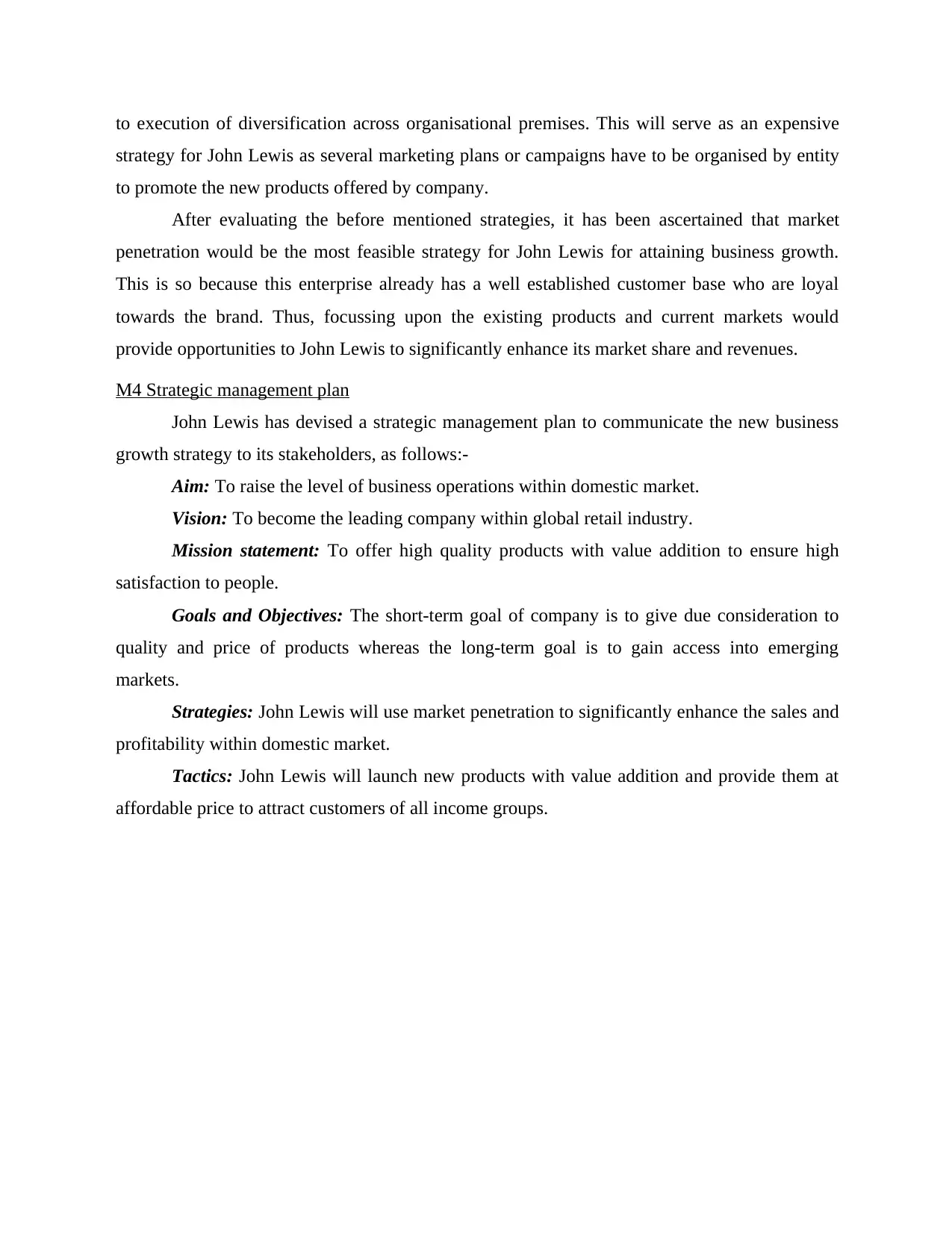
to execution of diversification across organisational premises. This will serve as an expensive
strategy for John Lewis as several marketing plans or campaigns have to be organised by entity
to promote the new products offered by company.
After evaluating the before mentioned strategies, it has been ascertained that market
penetration would be the most feasible strategy for John Lewis for attaining business growth.
This is so because this enterprise already has a well established customer base who are loyal
towards the brand. Thus, focussing upon the existing products and current markets would
provide opportunities to John Lewis to significantly enhance its market share and revenues.
M4 Strategic management plan
John Lewis has devised a strategic management plan to communicate the new business
growth strategy to its stakeholders, as follows:-
Aim: To raise the level of business operations within domestic market.
Vision: To become the leading company within global retail industry.
Mission statement: To offer high quality products with value addition to ensure high
satisfaction to people.
Goals and Objectives: The short-term goal of company is to give due consideration to
quality and price of products whereas the long-term goal is to gain access into emerging
markets.
Strategies: John Lewis will use market penetration to significantly enhance the sales and
profitability within domestic market.
Tactics: John Lewis will launch new products with value addition and provide them at
affordable price to attract customers of all income groups.
strategy for John Lewis as several marketing plans or campaigns have to be organised by entity
to promote the new products offered by company.
After evaluating the before mentioned strategies, it has been ascertained that market
penetration would be the most feasible strategy for John Lewis for attaining business growth.
This is so because this enterprise already has a well established customer base who are loyal
towards the brand. Thus, focussing upon the existing products and current markets would
provide opportunities to John Lewis to significantly enhance its market share and revenues.
M4 Strategic management plan
John Lewis has devised a strategic management plan to communicate the new business
growth strategy to its stakeholders, as follows:-
Aim: To raise the level of business operations within domestic market.
Vision: To become the leading company within global retail industry.
Mission statement: To offer high quality products with value addition to ensure high
satisfaction to people.
Goals and Objectives: The short-term goal of company is to give due consideration to
quality and price of products whereas the long-term goal is to gain access into emerging
markets.
Strategies: John Lewis will use market penetration to significantly enhance the sales and
profitability within domestic market.
Tactics: John Lewis will launch new products with value addition and provide them at
affordable price to attract customers of all income groups.
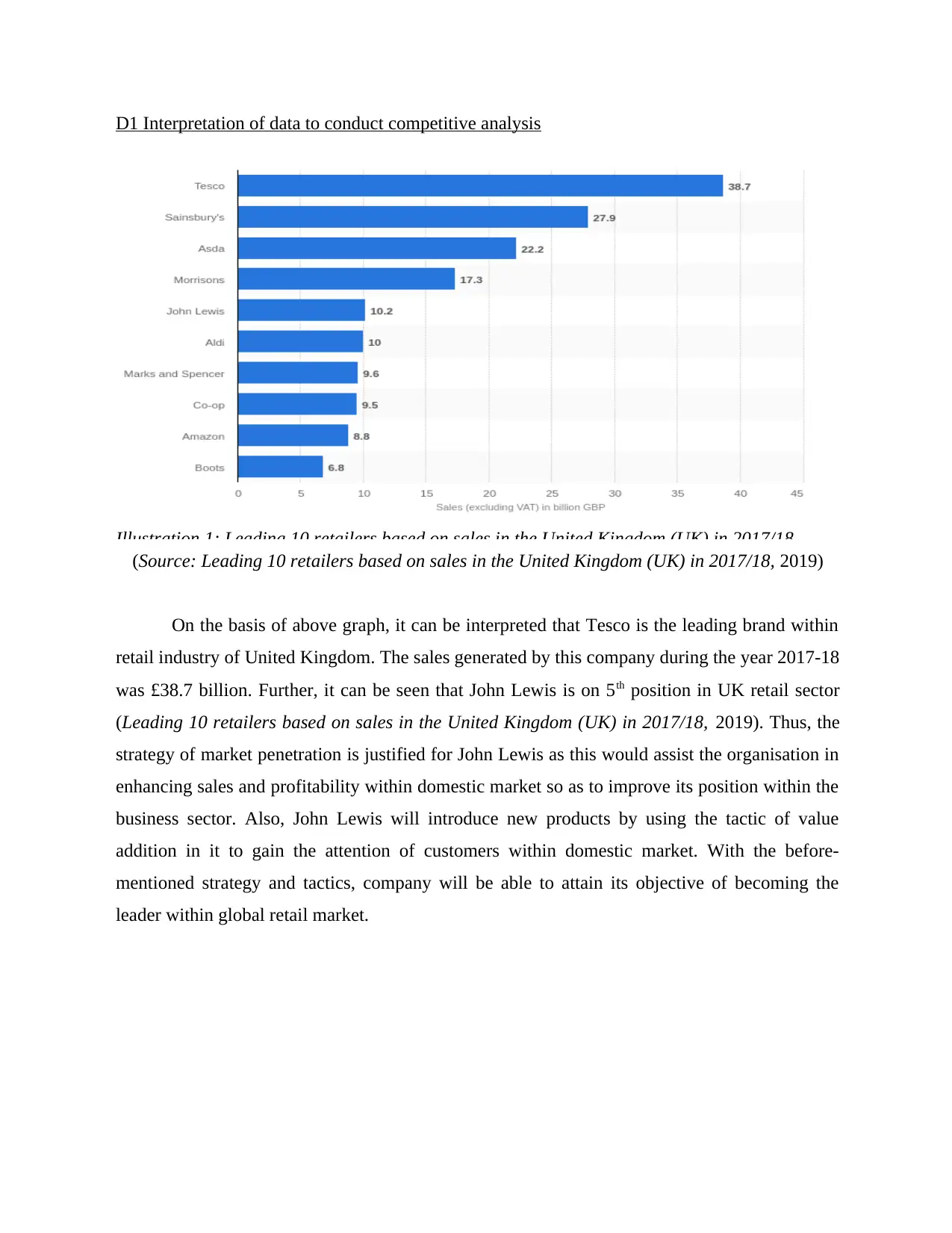
D1 Interpretation of data to conduct competitive analysis
Illustration 1: Leading 10 retailers based on sales in the United Kingdom (UK) in 2017/18
(Source: Leading 10 retailers based on sales in the United Kingdom (UK) in 2017/18, 2019)
On the basis of above graph, it can be interpreted that Tesco is the leading brand within
retail industry of United Kingdom. The sales generated by this company during the year 2017-18
was £38.7 billion. Further, it can be seen that John Lewis is on 5th position in UK retail sector
(Leading 10 retailers based on sales in the United Kingdom (UK) in 2017/18, 2019). Thus, the
strategy of market penetration is justified for John Lewis as this would assist the organisation in
enhancing sales and profitability within domestic market so as to improve its position within the
business sector. Also, John Lewis will introduce new products by using the tactic of value
addition in it to gain the attention of customers within domestic market. With the before-
mentioned strategy and tactics, company will be able to attain its objective of becoming the
leader within global retail market.
Illustration 1: Leading 10 retailers based on sales in the United Kingdom (UK) in 2017/18
(Source: Leading 10 retailers based on sales in the United Kingdom (UK) in 2017/18, 2019)
On the basis of above graph, it can be interpreted that Tesco is the leading brand within
retail industry of United Kingdom. The sales generated by this company during the year 2017-18
was £38.7 billion. Further, it can be seen that John Lewis is on 5th position in UK retail sector
(Leading 10 retailers based on sales in the United Kingdom (UK) in 2017/18, 2019). Thus, the
strategy of market penetration is justified for John Lewis as this would assist the organisation in
enhancing sales and profitability within domestic market so as to improve its position within the
business sector. Also, John Lewis will introduce new products by using the tactic of value
addition in it to gain the attention of customers within domestic market. With the before-
mentioned strategy and tactics, company will be able to attain its objective of becoming the
leader within global retail market.
⊘ This is a preview!⊘
Do you want full access?
Subscribe today to unlock all pages.

Trusted by 1+ million students worldwide
1 out of 14
Related Documents
Your All-in-One AI-Powered Toolkit for Academic Success.
+13062052269
info@desklib.com
Available 24*7 on WhatsApp / Email
![[object Object]](/_next/static/media/star-bottom.7253800d.svg)
Unlock your academic potential
Copyright © 2020–2025 A2Z Services. All Rights Reserved. Developed and managed by ZUCOL.





